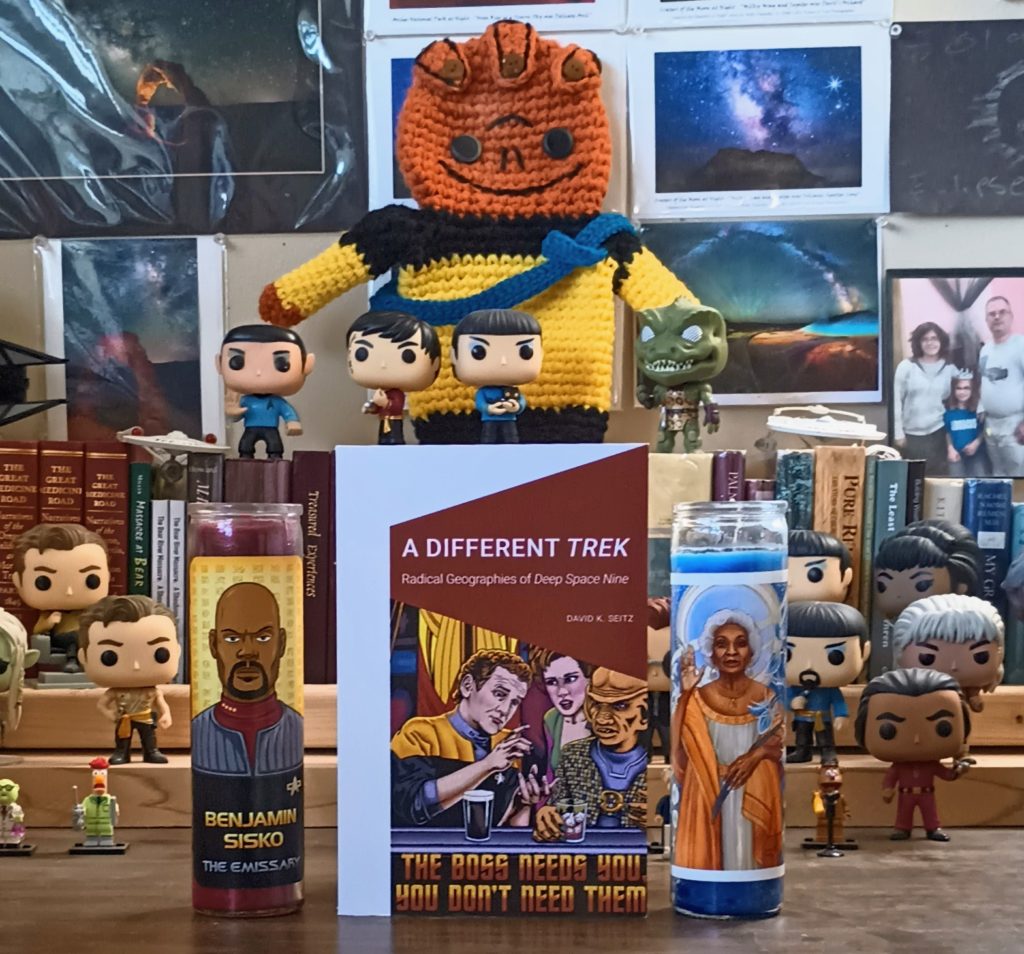Title: A Different Trek: Radical Geographies of Deep Space Nine
Author: David K. Seitz
Publisher: University of Nebraska Press
Year Published: 2023
Pages: 305
Genre: Nonfiction
ISBN: 9781496235428
Binding: Paperback
Price: $30
Reviewed by Kevin Folkman for the Association for Mormon Letters
If you are not familiar with the television series Star Trek: Deep Space Nine (DS9) you may ask why a review of David Seitz’s A Different Trek: Radical Geographies of Deep Space Nine would appear on the website for The Association for Mormon Letters. If you are familiar, you may recognize that many of the themes from the series have similarities to the history and theology of the Church of Jesus Christ of Latter-day Saints. DS9 raises questions about the separation of church and state, violence towards a religious group by oppressive neighbors, economic inequality, friction between conservative and progressive elements within a religion, and the role of prophets and religious leaders in an advanced technological culture.
As such, DS9 is a radical departure from the rest of the Star Trek universe. Original Star Trek creator Gene Roddenberry envisioned that humankind had progressed beyond capitalism, inequality, and religion to a thoroughly secular and prosperous future. Whereas the original Star Trek series and its sequel, Star Trek: The Next Generation, were moving about the galaxy encountering new worlds, DS9 takes place primarily in a single location, a space station on the borders of human expansion. In that scenario, DS9 is closely tied to the Bajoran homeworlds, recently freed from the control of alien invaders who colonized the Bajoran people and forced them into slave labor. The Bajorans are highly religious, looking for inspiration and guidance via their religious leaders, the Prophets of the Celestial Temple. These prophets exist in another dimension within a wormhole, a gateway between galaxies that is beyond normal concepts of time and place. This is not the secular utopia foreseen by Roddenberry. In other words, DS9 looks like what happens when the utopian Zion-like Federation meets the messy reality of human (and human-like) existence on the frontier.
In this environment, cultural, economic, political, and religious conflicts abound. Religion and cultural scholar Seitz explores this environment in A Different Trek: Radical Geography of Deep Space Nine. Drawing comparisons between our current cultural milieu and the universe as depicted in DS9, Seitz presents us with a much more nuanced view of the typical utopian-oriented views of science fiction. Not everything is wonderful, nor is it as bleak as some of the more dystopian and apocalyptic takes on our future. In short, DS9 holds up a mirror to our own times in a direct manner that begs us to see the future we might create from the present we now live in.
Seitz writes about the episodes in DS9 that examine how violence and economic inequity forced humankind to see a better way. Black Federation of Planets officer Benjamin Sisko, the commander of the Deep Space Nine station, gets to address the roots of 20th-century racism in an episode that flashes back to a difficult time in our own world. Family relationships play a major part in DS9, a departure from other Star Trek series. Sisko arrives at the station with his teenage son, having recently lost his wife and much of his reason for living. Sisko’s father also plays a major role in his life. The station’s chief engineer Miles O’Brien has a wife who teaches school on the station and two children growing up in this tense border environment. Couples find each other and marry. Garak, a gay alien tailor struggles with both his sexuality and his otherness as part of the race that occupied Bajor. Stripped of their other-worldly setting, these themes should all be familiar to LDS readers.
In short, Deep Space Nine, more than any other Star Trek series, deals directly with our present problems in a messy, difficult imagining of what our world might be like as we expand into the cosmos. In some ways, A Different Trek can be a difficult read, as it draws upon multiple academic disciplines to examine the world of DS9. But if you are a Star Trek Fan, stick with it. The parallels between the LDS religious experience and the world of DS9 are striking. The world of Deep Space Nine may be 400 years in our future, but in a religious tradition where eternity is a constant emphasis, it really is not that far off. In A Different Trek author Seitz gives us a lot to think about as we contemplate our present and our possible futures.

